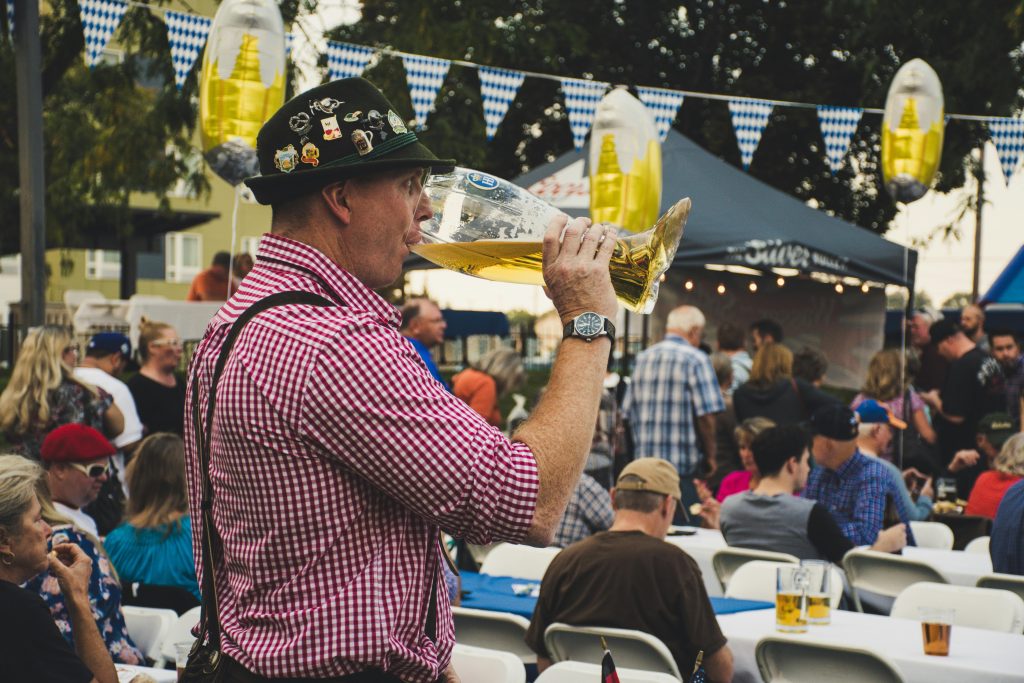A Journey Beyond Grief: Finding Life in the Marigold Maze of Mexico’s Day of the Dead

What is the Day of the Dead (Día de Muertos) in Mexico? This is Mexico’s most iconic annual celebration, held from November 1st and 2nd, to honor and welcome the spirits of departed loved ones back home. Far from a somber occasion, it is a joyful and deeply meaningful tribute to memory, love, and life itself. In Mexican belief, the opposite of life is not death, but being forgotten. With its dazzling colors, fragrant marigolds, and lively gatherings, Día de Muertos invites visitors to experience a transformative journey into Mexican culture, where remembrance becomes celebration and loss turns into reunion.
The Cycle of Life: Mexico’s Ancient View of Mortality
To truly understand Día de Muertos, we must look beyond the spectacle to its ancient roots. Long before the Spanish arrived in the 16th century, the peoples of Mesoamerica; the Aztecs, Toltecs, and Maya, held a worldview profoundly different from the modern Western one. To them, death was not an end but a vital phase in the great cycle of existence: a harvest, a regeneration, the fertile soil from which new life emerges.
For the Mexica (Aztecs), the universe was inherently fragile, requiring constant nourishment to endure. This belief shaped their rituals, including human sacrifice. Offering blood and the heart to the gods was not seen as cruelty but as sacred reciprocity, a cosmic exchange ensuring the world’s continuation. Life, they believed, was born from death.

In Aztec cosmology, the soul’s fate after death depended not on morality but on the manner of one’s passing. Warriors who died in battle joined the sun’s ascent, while those who died naturally journeyed to Mictlán, the serene underworld of rest. The Maya shared this vision of death as renewal, where ancestors continued to guide the living. Families buried their dead with food, tools, and a faithful dog to aid the soul’s passage. Even the Aztec calendar devoted two months to honoring the departed; one for children and one for adults, under the watch of Mictēcacihuātl, the Lady of the Dead.
This millennia-old tradition of cyclical life, death, and remembrance refused to vanish when Spanish Catholicism was introduced. The Catholic missionaries, aiming for conversion, found it easier to co-opt rather than crush these deep traditions. They moved the indigenous festivals of the dead to coincide with the Christian holidays of All Saints’ Day (November 1st) and All Souls’ Day (November 2nd). The result was a powerful, beautiful syncretism, a spiritual hybrid, creating the Día de Muertos we celebrate today.
A Festival of Reunion
Today, the Día de Muertos transforms the entire country into a pulsating, ephemeral art installation. The air, heavy with the sweet, smoky scent of copal incense, crackles with energy. The country is saturated in a palette that laughs in the face of somber mourning: vibrant papel picado (intricately cut tissue paper) and the glorious gold of the cempasúchil (the Mexican marigold).

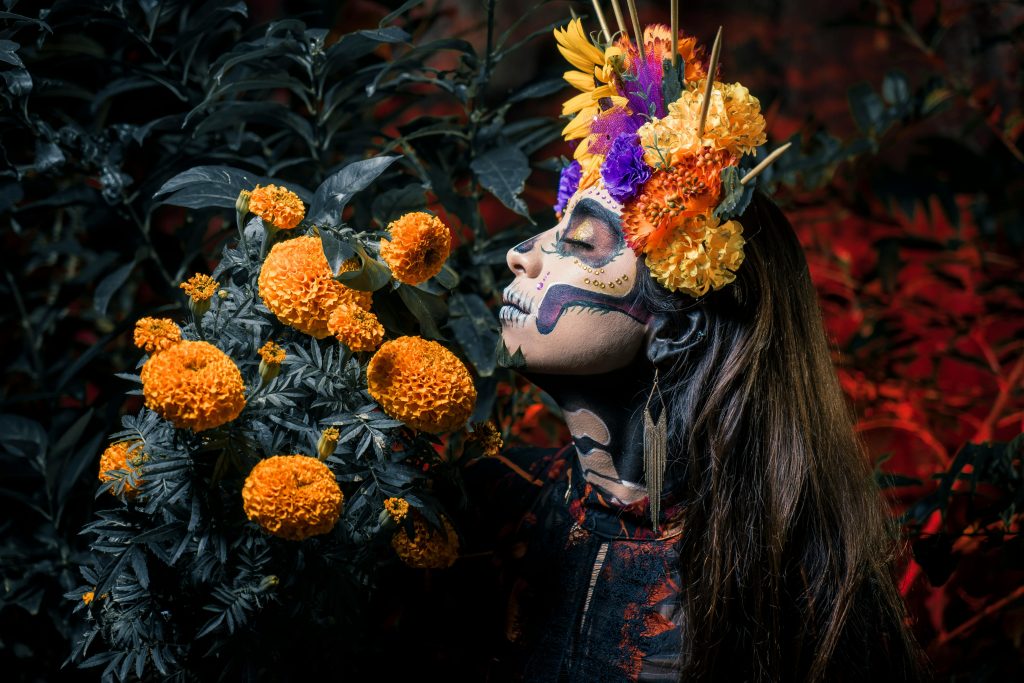
These marigolds, known as the ‘Flower of the Dead,’ are the key to the reunion. Their potent fragrance and sun-yellow petals are believed to attract and guide the souls of the dead back to their homes. They line paths and blanket the multi-tiered altars, or ofrendas, erected in every home, public square, and cemetery.
The ofrenda is the heart of the celebration, a shrine packed with personalized offerings: a glass of water, salt for purification, candles to light the way, and a portrait of the beloved. Crucially, it’s topped with the deceased’s favorite things; a bottle of mezcal, a favorite meal, and a slice of pan de muerto (the sweet, bone-shaped bread). It is an act of intimate memory and radical hospitality, welcoming the departed to feast and be remembered.
In cities like Oaxaca and Mexico City, enormous parades flood the streets, and people transform themselves into the iconic La Catrina, the elegant, high-society skeleton created by artist José Guadalupe Posada to satirize the wealthy who denied their indigenous roots. She is the ultimate Mexican icon of death: democratic, beautiful, and a reminder that no matter your status, we all end up as skeletons. The entire country engages in a celebratory mockery of mortality, proving that love, not fear, is the strongest emotion connected to the inevitable.
A Tradition Under the Global Spotlight
| Photo by: Natalia C

For those of us visiting, the festival is a sensory spectacle, but for locals, it is a deeply personal, ancestral ritual. And the growing global attention has created a complex dynamic, one wrestled with by people like Natalia Cabarga, the founder of Walk Mexico Tour.
As an art historian and a certified tourist guide, Natalia’s love for Mexico’s culture and history radiates from her. When we spoke, she confessed to the struggle of seeing her sacred tradition become a global tourist magnet. “When Hollywood films started featuring our parades and the government also began promoting it as a tourism magnet, I was sad,” she admitted. “I worried we were losing the soul of the celebration to commerce.”
But her work leading immersive tours offered her a new perspective, one that healed her own anxieties about modernity. She watched as people from small villages and remote towns, who rarely travel, saved up all year to participate in the grand city parades, pouring their hearts and resources into their elaborate Catrina costumes and community floats. “I saw the genuine, beautiful effort of thousands of Mexican people who were so excited to share their culture with the world,” she recalled. “Their participation was an act of cultural affirmation. It was heartwarming to see that our tradition was not dying, it was multiplying.”
A Moment of Healing Beyond Tourism
Natalia’s most treasured memory, however, came during a small, quiet ritual she introduced into her tours. After laying the groundwork, she took her travelers to a neighborhood ofrenda and offered them a simple yet profound opportunity. “I asked each participant if they wanted to place a picture of their own loved one who had passed away onto the altar,” she explained. “It was a tiny gesture, a moment of connection that transcended language or culture.”
Almost immediately, the response was overwhelming. She described the change on people’s faces; the momentary break in the tourist façade as they gently placed a grandmother’s photo or a cherished friend’s picture next to a glass of water and a bright marigold. In that moment, they felt seen, their grief honored in a way they never had before,” Natalia said. “Some people cried. It wasn’t just a tour moment; it was a beautiful, healing moment. In the end, they understood that on this night, the veil was thin, and they were, in a way, communing with the person they missed.”
Experience the heart of Mexico’s Day of the Dead with Natalia; an immersive, thoughtful tour you can book here.
Your Journey of Transformation
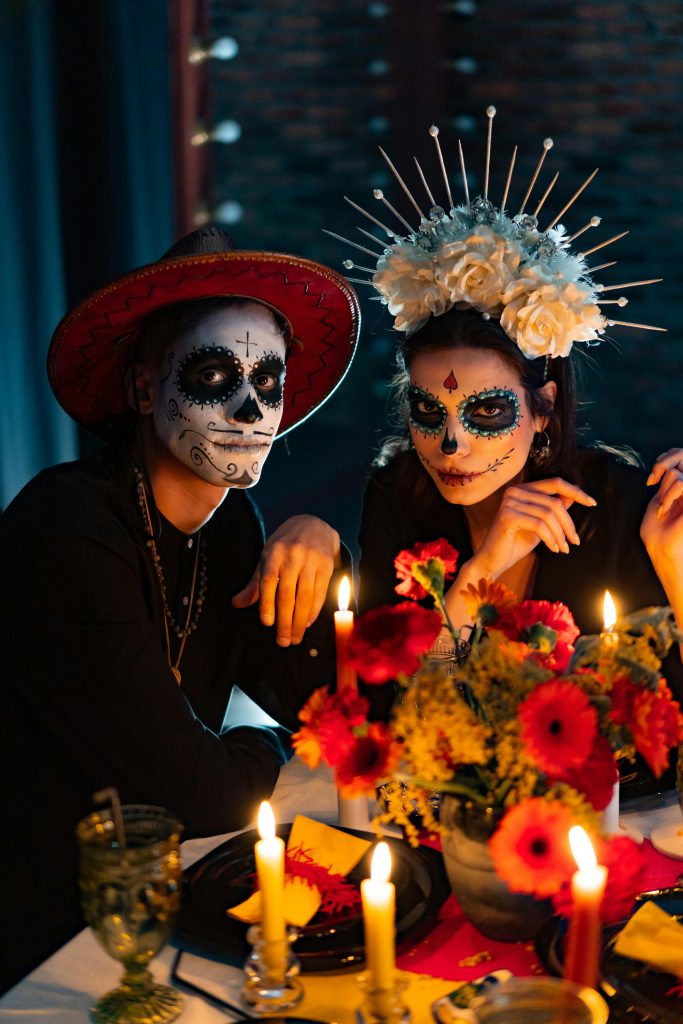
The Día de Muertos is more than a holiday. It’s a spiritual experience that reshapes your relationship with loss, showing that a soul remembered is never truly gone. It transforms fear into acceptance, joy, and connection.
To feel the tradition’s true healing power, an immersive tour is essential. With an expert like Natalia Cabarga, you move beyond the tourist crowds and into the heart of authentic rituals, guided with knowledge and sensitivity.
You return home not just with souvenirs, but with a lighter view of mortality and a deeper appreciation for the bonds that endure, seeing death not as an ending, but as a reason to celebrate life.
To ensure your visit honors the spirit of the holiday, follow these guidelines:
- Respect the Cemeteries: Cemeteries (like those in Pátzcuaro or Mixquic) are sacred family spaces. Ask before taking photos, speak softly, and avoid disturbing family vigils.
- Ofrendas are Private Invitations: Altars in private homes are intimate. Only approach or photograph a public ofrenda in a museum or plaza.
- The Catrina Look: If you choose to wear skull makeup, understand that it is a complex cultural symbol, not a simple costume. Use it as a respectful tribute to La Catrina and the indigenous philosophy of death.
- Book an Immersive Tour: For a truly enriching experience, book a tour with a local expert like Natalia Cabarga’s Walk Mexico Tour. Their in-depth knowledge and respectful approach are invaluable for a “one-in-a-lifetime experience.”
Ready to embrace the beauty of remembrance and transform your view of mortality?
Affiliate disclaimer: Some of the links on this website are affiliate links. This means that if you click on them and make a purchase, we may earn a small commission—at no extra cost to you. These commissions help support the work we do in creating thoughtful travel stories and guides. We only recommend products, services, and experiences that we believe bring genuine value to travelers.

Deti Lucara
Writer | FounderA writer and traveler from Indonesia, and the founder of thecharmingworld.com, a community-driven magazine inspired by my love for art, culture, and human connection. I created this space for kindred souls who believe that true beauty is found in wonder, curiosity, and the stories we share along the way.

